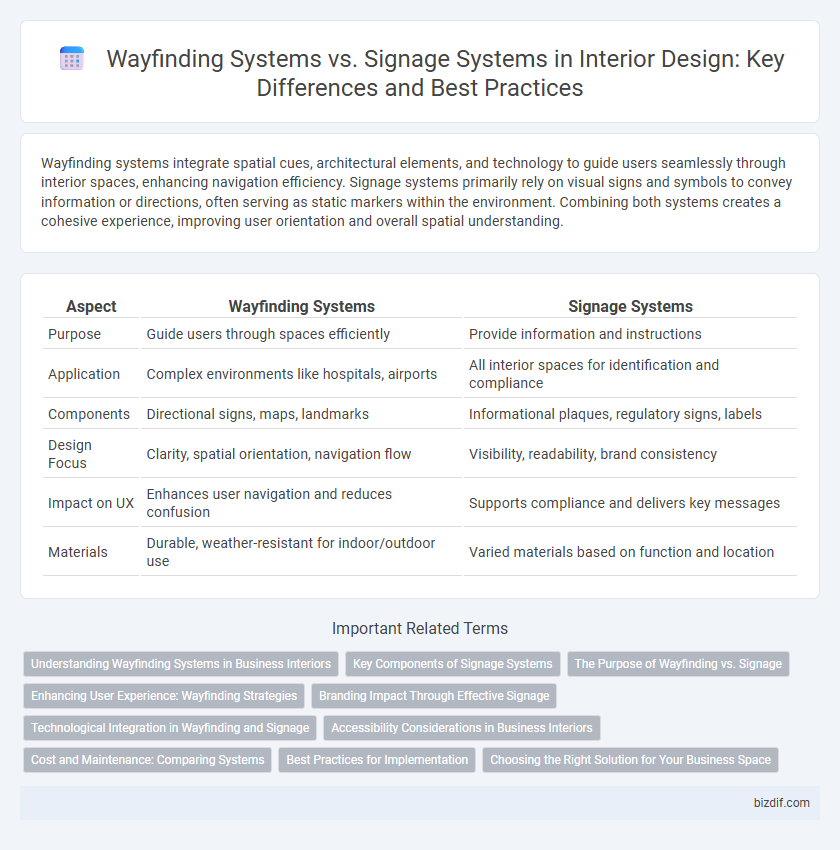Wayfinding systems integrate spatial cues, architectural elements, and technology to guide users seamlessly through interior spaces, enhancing navigation efficiency. Signage systems primarily rely on visual signs and symbols to convey information or directions, often serving as static markers within the environment. Combining both systems creates a cohesive experience, improving user orientation and overall spatial understanding.
Table of Comparison
| Aspect | Wayfinding Systems | Signage Systems |
|---|---|---|
| Purpose | Guide users through spaces efficiently | Provide information and instructions |
| Application | Complex environments like hospitals, airports | All interior spaces for identification and compliance |
| Components | Directional signs, maps, landmarks | Informational plaques, regulatory signs, labels |
| Design Focus | Clarity, spatial orientation, navigation flow | Visibility, readability, brand consistency |
| Impact on UX | Enhances user navigation and reduces confusion | Supports compliance and delivers key messages |
| Materials | Durable, weather-resistant for indoor/outdoor use | Varied materials based on function and location |
Understanding Wayfinding Systems in Business Interiors
Wayfinding systems in business interiors enhance navigation by using spatial markers, maps, and digital interfaces that guide visitors intuitively through complex environments. Unlike traditional signage systems that primarily provide static information, wayfinding integrates environmental cues and interactive technology to improve user experience and reduce confusion. Effective wayfinding strategies contribute to operational efficiency and reinforce brand identity within commercial spaces.
Key Components of Signage Systems
Signage systems in interior design primarily consist of key components such as directional signs, identification signs, and informational signs, all designed to enhance user navigation and spatial understanding. These components utilize clear typography, color coding, and standardized symbols to effectively communicate messages and guide occupants throughout a space. Proper integration of materials, lighting, and placement ensures visibility and durability, optimizing the overall wayfinding experience.
The Purpose of Wayfinding vs. Signage
Wayfinding systems guide people through complex spaces by providing directional cues and spatial information, enhancing navigation efficiency and user experience. Signage systems primarily communicate specific information or instructions, such as room identification, safety alerts, or regulations. While both aid orientation, wayfinding focuses on facilitating movement and spatial awareness, whereas signage delivers discrete messages within an environment.
Enhancing User Experience: Wayfinding Strategies
Wayfinding systems enhance user experience by providing intuitive navigation through spatial cues, landmarks, and maps that reduce confusion and stress in complex environments. These strategies enable users to easily locate destinations by integrating visual hierarchy, consistent iconography, and clear directional paths. Signage systems support wayfinding by offering essential information, but wayfinding strategies focus on holistic spatial orientation that promotes seamless movement and confidence during navigation.
Branding Impact Through Effective Signage
Wayfinding systems and signage systems play distinct roles in interior design, yet both are crucial for enhancing branding impact through effective signage. Wayfinding systems prioritize directional cues that guide visitors seamlessly within a space, reinforcing brand identity through consistent visual elements like logos, color schemes, and typography. Signage systems focus on clear communication of information and brand values, using strategic placement and design to create memorable experiences that strengthen brand recognition and customer loyalty.
Technological Integration in Wayfinding and Signage
Wayfinding systems integrate advanced technologies such as GPS, Bluetooth beacons, and mobile apps to provide dynamic, real-time navigation, enhancing user experience through personalized routing and interactive maps. Signage systems increasingly incorporate digital displays, QR codes, and NFC tags to deliver updated information and facilitate seamless communication between users and environments. Both systems leverage IoT and AI to adapt to changing conditions, improving accessibility, safety, and efficiency in interior spaces.
Accessibility Considerations in Business Interiors
Wayfinding systems in business interiors prioritize accessible design by integrating tactile maps, braille labels, and audible cues to assist individuals with disabilities in navigating spaces independently. Signage systems enhance accessibility through high-contrast colors, large fonts, and universal symbols, ensuring clarity for users with visual impairments or cognitive challenges. Combining both systems creates an inclusive environment that complies with ADA standards and improves overall user experience for diverse occupants.
Cost and Maintenance: Comparing Systems
Wayfinding systems typically require higher initial investment and ongoing maintenance costs due to their integration of digital technology and interactive elements, contrasting with signage systems that involve lower upfront expenses and simpler upkeep. Digital wayfinding systems demand regular software updates, hardware repairs, and potentially specialized staff, increasing operational costs compared to static signage, which is more cost-effective and easier to maintain. Budget-conscious projects often prefer signage systems for cost-efficiency, while complex environments justify wayfinding systems to enhance user experience despite higher maintenance expenditures.
Best Practices for Implementation
Effective wayfinding systems integrate intuitive spatial cues, clear visual hierarchies, and consistent branding to guide users seamlessly through complex environments. Signage systems should prioritize legibility, strategic placement, and durable materials to ensure information is accessible and maintain clarity under various lighting conditions. Implementing user-centered design principles, including testing with diverse user groups and considering universal accessibility standards, enhances navigation efficiency and overall space usability.
Choosing the Right Solution for Your Business Space
Wayfinding systems prioritize intuitive navigation through spatial cues such as maps, landmarks, and pathways, enhancing user experience in complex business environments like hospitals or corporate campuses. Signage systems focus on clear, visible communication of information, directions, or rules using signs, often suited for straightforward guidance or branding purposes. Selecting the right solution depends on the complexity of the space and user needs, with wayfinding ideal for multi-level or expansive layouts, while signage works well in smaller, less complex areas.
Wayfinding systems vs Signage systems Infographic

 bizdif.com
bizdif.com